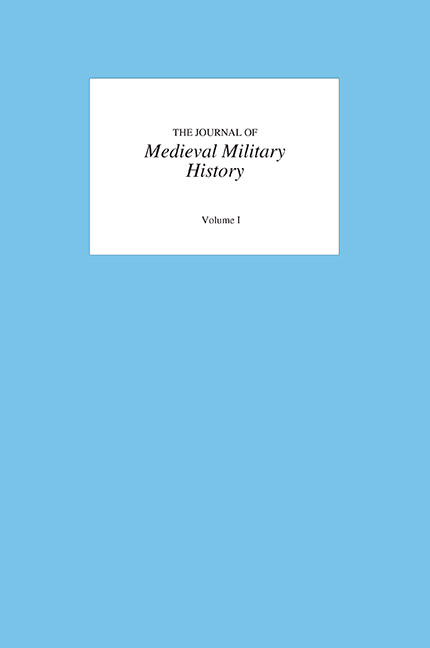Book contents
- Frontmatter
- Contents
- Editor's Introduction
- 1 The Vegetian ‘Science of Warfare’ in the Middle Ages
- 2 Battle Seeking: The Contexts and Limits of Vegetian Strategy
- 3 Italia – Bavaria – Avaria: The Grand Strategy behind Charlemagne's Renovatio Imperii in the West
- 4 The Composition and Raising of the Armies of Charlemagne
- 5 Some Observations on the Role of the Byzantine Navy in the Success of the First Crusade
- 6 Besieging Bedford: Military Logistics in 1224
- 7 ‘To aid the Custodian and Council;’ Edmund of Langley and the Defense of the Realm, June – July 1399
- 8 Flemish Urban Militias against the French Cavalry Armies in the Fourteenth and Fifteenth Centuries
7 - ‘To aid the Custodian and Council;’ Edmund of Langley and the Defense of the Realm, June – July 1399
Published online by Cambridge University Press: 12 September 2017
- Frontmatter
- Contents
- Editor's Introduction
- 1 The Vegetian ‘Science of Warfare’ in the Middle Ages
- 2 Battle Seeking: The Contexts and Limits of Vegetian Strategy
- 3 Italia – Bavaria – Avaria: The Grand Strategy behind Charlemagne's Renovatio Imperii in the West
- 4 The Composition and Raising of the Armies of Charlemagne
- 5 Some Observations on the Role of the Byzantine Navy in the Success of the First Crusade
- 6 Besieging Bedford: Military Logistics in 1224
- 7 ‘To aid the Custodian and Council;’ Edmund of Langley and the Defense of the Realm, June – July 1399
- 8 Flemish Urban Militias against the French Cavalry Armies in the Fourteenth and Fifteenth Centuries
Summary
On 1 June 1399 Edmund of Langley, Duke of York, became custodian of the realm for the third and last time. His nephew and king, Richard II, had gone to Ireland with a substantial force of men to quell rebellious subjects there and, no doubt, the aged duke expected to spend an uneventful year as titular head of the government. By the middle of June, however, Henry of Bolingbroke, disinherited Duke of Lancaster, had organized a small army, and left the port of Boulogne in France; he then lay off the southern coast looking for a likely place to invade the kingdom and reclaim his inheritance. Henry's actions set in motion a series of events that would see the fall and deposition of Richard II by the end of September.
These events surrounding the collapse of the Ricardian regime have received a good deal of recent historical attention. Chris Given-Wilson, Nigel Saul and Michael Bennett have recently produced narratives of the 1399 campaign, and much has been written on Richard's army in Ireland, but in spite of the fact that a reasonable amount of untapped documentary evidence exists, Edmund of Langley's defense of the realm is relegated in brief to the narrative of events.
Often York has been charged with being a weak and ineffective leader, and is sometimes blamed by historians for failing to save Richard's crown.
This study challenges the existing historiography by undertaking a detailed analysis of Edmund of Langley's attempts to defend Richard II's kingdom in the face of invasion. It will not only discuss York's initial military position and preparations, but also focus on the logistics surrounding the raising of his field army. Although Chris Given-Wilson has provided historians with a fine resource by printing some numbers for Duke Edmund's army, these are incomplete. Unfortunately, Given-Wilson did not track the Exchequer's largely successful efforts in calling the captains of various contingents to account for their troops and time served that were recorded on the Foreign Rolls (E 364). Although it took until 1407 for the Exchequer to track down some captains from York's army, when these entries from the Foreign Rolls are collated and compiled, and added to the material available on the Issue Rolls, they provide a much clearer picture as to who served with York and allow for some prosopographical analysis of his field army.
- Type
- Chapter
- Information
- Journal of Medieval Military HistoryVolume I, pp. 125 - 144Publisher: Boydell & BrewerPrint publication year: 2002

